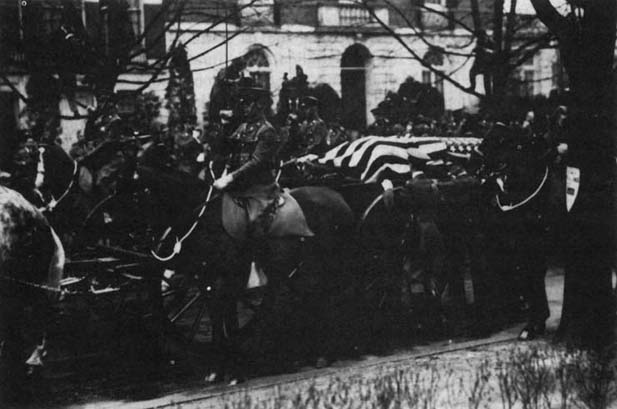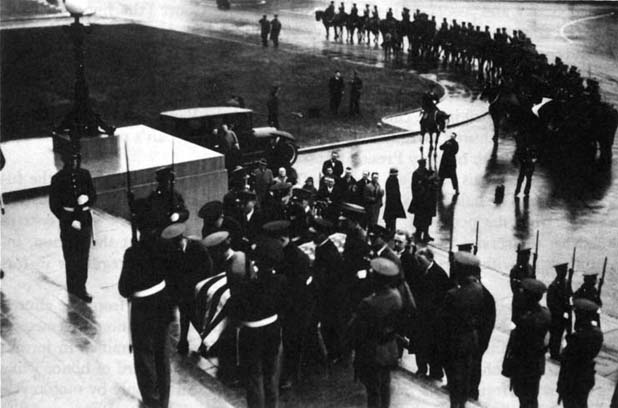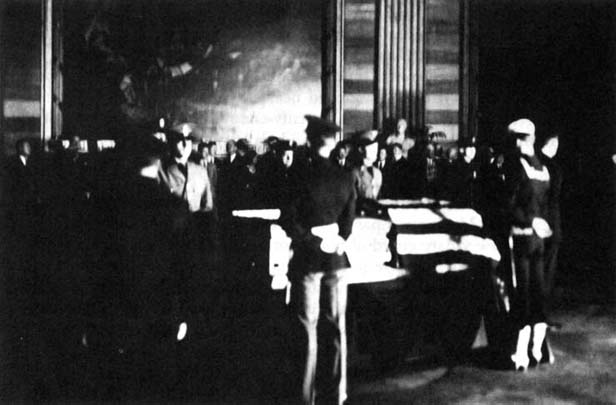|
The Last Salute: Civil and Military Funeral,
1921-1969
CHAPTER II
Former President William Howard Taft
State Funeral
8-11 March 1930
After a long illness William Howard Taft, at the age of seventy-two,
died at his home in Washington, D.C., late in the afternoon of 8 March
1930. Mr. Taft, the only man to have held both the office of President
and of Chief Justice of the United States, was accorded a State Funeral
in Washington with full military honors.
The responsibility for arranging and conducting the funeral was assigned
to the Commanding General, 16th Brigade, stationed at Fort Hunt, Virginia.
President Herbert Hoover meanwhile appointed his own aide, Col. Campbell
B. Hodges, to assist the Taft family and help coordinate funeral arrangements.
According to plans the ceremonies, all scheduled for 11 March, were
to begin at 0900 when Mr. Taft's body was to be escorted from his residence
to the Capitol to lie in state on the Lincoln catafalque in the rotunda
until noon. A procession would then form to accompany the body to All
Souls' Unitarian Church for the funeral service. President Hoover had
offered the East Room of the White House for the service, but Mrs. Taft
declined since her husband had asked that it be held in the church of
which he was a communicant. Dr. Ulysses G. B. Pierce, pastor of the
church and long-time friend of Mr. Taft, was to conduct both the funeral
and the graveside service. The members of the Supreme Court were to
be honorary pallbearers.
At the request of the family, burial was to be in Arlington National
Cemetery. Mr. Taft would be the first President buried there. Following
the funeral service, a motor procession without military escort was
to accompany the body to the Fort Myer Gate of the cemetery. There a
military escort was to meet the motorcade and conduct it to the gravesite,
a 2,500-square-foot plot in the northeastern area which held few graves
but was well landscaped. Mrs. Taft and her two sons and daughter, accompanied
by Colonel Hodges and Col. Charles G. Mortimer, the officer in charge
at Arlington, had visited the cemetery on 9 March and selected the site.
Extensive military honors were scheduled after President Hoover on 8
March proclaimed a thirty-day period of national mourning and formally
directed the Secretary of War and Secretary of the Navy to render "suitable
military and naval
[19]
honors" on the day of the funeral. As prescribed in existing regulations,
all Army posts possessing the necessary equipment prepared to fire thirteen
guns at reveille, one each half hour thereafter until retreat, and then
a 48-gun salute to the Union on Monday, 10 March. This was the salute
customarily fired upon receipt of news of the death of a President or
ex-President except, as in the case of Mr. Taft, when the notice was
received on a Sunday.
Also by established custom, and as specifically directed by Secretary
of War Patrick J. Hurley through Army Chief of Staff General Charles
P. Summerall, Army posts were to fire twenty-one minute guns at 1430
on 11 March, the time scheduled for the end of the funeral service.
Flags were to be displayed at halfstaff, colors and standards were
to be draped in mourning, and all officers were to wear "the usual
badge of military mourning around the left sleeve of the uniform coat
and overcoat and on the saber" for thirty days. Similarly, Navy
instructions prescribed that on the day of the funeral "the ensign
at each naval station and on board each vessel in commission be displayed
at half mast and that a gun be fired at half-hour intervals from sunrise
to sunset at each naval station and on board flagships and all saluting
ships acting singly." Officers of the Navy and Marine Corps also
were to wear mourning badges for thirty days.
Although existing regulations established the military honors to be
rendered during the ceremonies in Washington, the size of the military
escorts in the funeral of a former President was left to the Secretary
of War. A squadron of cavalry (two troops), it was decided, would escort
Mr. Taft's body from the Taft home to the Capitol. The main procession
from the Capitol to the church was to include two service bands, a battalion
of infantry, a battalion of field artillery, a battalion of marines,
and a company of bluejackets. The escort commander, another choice left
to the Secretary of War, was to be Maj. Gen. Fred W. Sladen, the commanding
general of the Third Corps Area, with headquarters in Baltimore, Maryland.
At the cemetery, a squadron of cavalry and a mounted band were to escort
the motorcade from the gate to the gravesite. A service band, a cavalry
regiment, less one squadron, a battalion of engineers, and a company
of marines were to stand in formation at the graveside service.
Almost all the ceremonies involved the 3d Cavalry Regiment, the "President's
Own," stationed at Fort Myer, Virginia, after World War I and consistently
called upon to render funeral honors. Besides furnishing the cavalry
contingents of the escorts, the regiment was to supply the caisson and
caisson detachment, four of eight body bearers (four from the Army,
two from the Navy, two from the Marine Corps), half the guard of honor
at the Capitol (twenty from the Army, ten from the Navy, ten from the
Marine Corps), and the saluting battery, firing party, and bugler at
the cemetery.
The 3d Cavalry alone was to provide the escort from the Taft residence
to the Capitol and from the cemetery gate to the grave. In the main
procession from the
[20]

CASKET IS PLACED ON CAISSON OUTSIDE THE TAFT HOME, above.
Procession to the Capitol, below.

[21]
Capitol to All Souls' Unitarian Church, the escort commanded by General
Sladen was to include the U.S. Army Band and the 1st Battalion, 16th
Field Artillery, from Fort Myer, Virginia; the 3d Battalion, 12th Infantry,
from Fort Washington, Maryland; the US Marine Band and a battalion of
marines from the Marine Barracks, Washington; and a company of bluejackets
from the Naval District Washington, in that order of march. At the grave,
the US Navy Band; the 3d Cavalry Regiment, less one squadron; a battalion
of the 13th Engineers from Fort Humphreys (later Fort Belvoir), Virginia;
and a company of marines were to form a hollow square around the perimeter
of the large gravesite as a guard of honor during the graveside service.
In a misty rain, the 2d Squadron, 3d Cavalry, caisson detachment, and
body bearers reached the Taft home at 2215 Wyoming Avenue, N.W., shortly
before 0900 on 11 March. Facing the residence from the opposite side
of the street, the mounted troops formed a front as the body bearers
brought the casket from the house and secured it on the caisson.
Neither officials nor members of the family rode in the procession to
the Capitol. With Metropolitan Police leading the way and the caisson
between Troop E in front and Troop F to the rear, the procession made
its way to the Capitol via Connecticut Avenue, Massachusetts Avenue,
16th Street, H Street, Madison Place, East Executive Avenue, Treasury
Place, and Pennsylvania Avenue. Rain fell heavily as it moved over the
northeast Capitol driveway to the East Plaza.
After the casket was carried into the rotunda and an honor guard, commanded
by Capt. Frank Goettge, a White House aide, was posted, an hour and
a half remained of the scheduled period of lying in state. Some 7,000
persons in two lines filed by during that time, despite interruptions
each fifteen minutes when a new honor guard relief took post.
At noon the casket was taken from the rotunda to the caisson on the
East Plaza, where the entire escort had formed for the procession to
the church. The Army Band led off, followed by the caisson and the remainder
of the escort. As in the morning ceremony, officials and members of
the family did not ride with the procession. As the column retraced
its morning route as far as 16th Street, then turned north to All Souls'
Unitarian Church at Harvard Street, a heavy downpour of rain with
strong winds made it difficult for the escort troops to maintain a precise
step and formation. Despite the weather, the public lined the entire
route as the procession, marching to the slow tempo of Chopin's "Funeral
March," spent almost two hours in reaching the church.
Considerably before the arrival of the cortege and escort from the Capitol,
some 900 people had filled All Souls' Unitarian Church. Orderly seating
was assured by Army officers acting as ushers under the direction of
Charles Lee Cooke, the ceremonial officer of the State Department. Among
those in attendance were President and Mrs. Hoover, Vice President Charles
Curtis, cabinet members, committees of the Senate and House of Representatives,
the Chief justice of the
[22]

CASKET IS CARRIED UP EAST STEPS OF THE CAPITOL, above.
Body of President Taft lies in state in the rotunda, below.

[23]
United States and associate justices of the Supreme Court (the honorary
pallbearers), state governors, Army and Navy officials, and many
members of the diplomatic corps.
Mrs. Taft and her family entered the church shortly before 1400, just
ahead of the arrival of the procession. As the cortege reached the canopied
entrance to the church a historic bell in the church steeple, made at
the Paul Revere Foundry and presented to the church in 1822,tolled the
message of Mr. Taft's passing, just as it had tolled the death of every
President since 1822.
Doctor Pierce, as Mr. Taft had requested, omitted any eulogies from
the funeral service. The half-hour program included a processional,
prayers, hymns, and readings from the poems of Wordsworth and Tennyson.
Network radio systems broadcast the service over nearly a hundred stations
throughout the nation, including some with short-wave transmitters that
were monitored regularly in foreign countries.
At the conclusion of the service, Mr. Taft's casket was borne from the
church and placed in a hearse for the motor procession to Arlington
National Cemetery. The military units of the escort from the Capitol,
which had remained information outside the church during the funeral
service, stood as a guard of honor while the motorcade formed and departed.
The procession, escorted only by motorcycle police, included a hundred
cars. The leading car carried Doctor Pierce and the second the honorary
pallbearers. The hearse came next, and was followed by cars bearing
the Taft family, President Hoover's car, and the cars of high government
officials. In some thirty minutes, the motorcade moved south on 16th
Street and New Hampshire Avenue, west on Pennsylvania Avenue and M Street
to Key Bridge (Memorial Bridge and Memorial Drive were under construction
at the time), then to Fort Myer and through it to the cemetery's Fort
Myer Gate.
The rain had stopped by the time the motor procession reached the gate.
The 3d Cavalry's saluting battery, positioned near the roadway in the
cemetery, signaled the arrival by firing the first of twenty-one minute
guns. Over the twenty minutes in which this salute was fired, the 3d
Cavalry's mounted band, at reduced cadence, and the 1st Squadron, which
had formed at the gate, escorted the motor procession to the gravesite.
At the grave the remainder of the 3d Cavalry (dismounted), the Engineer
battalion, and the Marine company, all together about a thousand men,
already were in the hollow square guard of honor formation. The honor
guard presented arms, ruffles and flourishes were sounded, and the Navy
Band played a hymn as the casket, followed by the Taft family and dignitaries,
was borne to the canopied grave. When Dr. Pierce concluded the brief
service, a 3d Cavalry firing party of sixteen men delivered the traditional
three volleys. The battery meanwhile had begun the final 21-gun salute.
At the end of the salute, taps was sounded for the twenty-seventh President
and tenth Chief Justice of the United States.
[24]
|